Diurnal Variations of Water Ice in the Martian Atmosphere Observed by Mars Climate Sounder
Abstract
:1. Introduction
2. Data and Methods
2.1. MCS Dataset
2.2. Data Averaging Strategy
2.3. The Diurnal Variation with Multi-Local Time Coverage
2.4. Quantification for the Diurnal Variation of Temperature and Water Ice
3. Results
3.1. The Latitude–Altitude Structure of Temperature and Water Ice DW1
3.2. Seasonal Variations of the Temperature and Water Ice DW1
3.3. The Correlation between Water Ice and Temperature DW1
4. Discussion
5. Conclusions
- The maximum amplitude of the water ice DW1 is comparable to the maximum in the day–night difference field, suggesting the dominant role of the DW1 component in the water ice diurnal variation;
- The water ice DW1 phase shares the same characteristics as the diurnal tide but is totally out of phase by ~12 h at the equinoxes, suggesting an accurate control of the sublimation/condensation by the thermal effect of the diurnal tide;
- The water ice DW1 amplitude shows a semiannual variation at the southern middle latitudes similar to the temperature DW1 (diurnal tide) but that varies more annually at the northern middle latitudes and equator region, with a persistent distribution during the entire aphelion seasons from 0° to 190° Ls but a remarkable reduction in the other half-year.
- The water ice DW1 phase generally has similar seasonal variations as the diurnal tide, with longer vertical wavelengths during the equinox compared to the solstice periods;
- The quantitative statistic suggests that the temperature and water ice DW1 phase are approximately anticorrelated (defined as a phase difference greater than 8 h) at most regions during the aphelion seasons, except for the layers between 10 and 20 Pa at the middle latitudes, while it is primarily out of phase or even in phase during the dusty seasons, especially in the lower atmosphere;
- In the aphelion seasons, the occurrence frequency of the antiphase relation is not sensitive to both the water ice opacity and dust opacity abundance but shows an increasing trend with the temperature DW1 amplitude;
- In the perihelion seasons, the antiphase relation is sensitive to both the water ice and dust opacity, i.e., the more water ice, the more it is anticorrelated, while the more dust, the less it is anticorrelated, both affected by the same process, i.e., the dust storm activity;
- Finally, the statistic results suggest an unexpected low threshold of the diurnal tide amplitude (2 to 3 K) for generating a relevant water ice diurnal variation, accounting for the ubiquitous water ice diurnal variations in the Martian atmosphere.
Author Contributions
Funding
Data Availability Statement
Acknowledgments
Conflicts of Interest
References
- Leovy, C. Weather and climate on Mars. Nature 2001, 412, 245. [Google Scholar] [CrossRef]
- Wu, Z.; Li, T.; Heavens, N.G.; Newman, C.E.; Richardson, M.I.; Yang, C.; Li, J.; Cui, J. Earth-like thermal and dynamical coupling processes in the Martian climate system. Earth Sci. Rev. 2022, 229, 104023. [Google Scholar] [CrossRef]
- Yu, Z.; Cui, P.; Crassidis, J.L. Design and optimization of navigation and guidance techniques for Mars pinpoint landing: Review and prospect. Prog. Aerosp. Sci. 2017, 94, 82–94. [Google Scholar] [CrossRef]
- Jiang, X.; Li, S. Enabling technologies for Chinese Mars lander guidance system. Acta Astronaut. 2017, 133, 375–386. [Google Scholar] [CrossRef]
- Montmessin, F.; Smith, M.D.; Langevin, Y.; Mellon, M.T.; Fedorova, A. The water cycle. Atmos. Clim. Mars 2017, 18, 338. [Google Scholar]
- Hinson, D.P.; Wang, H.; Wilson, J.; Spiga, A. Nighttime convection in water-ice clouds at high northern latitudes on Mars. Icarus 2022, 371, 114693. [Google Scholar] [CrossRef]
- Steele, L.J.; Kleinböhl, A.; Kass, D.M. Observations of Ubiquitous Nighttime Temperature Inversions in Mars’ Tropics After Large-Scale Dust Storms. Geophys. Res. Lett. 2021, 48, e2021GL092651. [Google Scholar] [CrossRef]
- Wilson, R.J.; Guzewich, S.D. Influence of water ice clouds on nighttime tropical temperature structure as seen by the Mars Climate Sounder. Geophys. Res. Lett. 2014, 41, 3375–3381. [Google Scholar] [CrossRef]
- Steele, L.J.; Lewis, S.R.; Patel, M.R. The radiative impact of water ice clouds from a reanalysis of Mars Climate Sounder data. Geophys. Res. Lett. 2014, 41, 4471–4478. [Google Scholar] [CrossRef] [Green Version]
- Kite, E.S.; Steele, L.J.; Mischna, M.A.; Richardson, M.I. Warm early Mars surface enabled by high-altitude water ice clouds. Proc. Natl. Acad. Sci. USA 2021, 118, e2101959118. [Google Scholar] [CrossRef]
- Smith, M.D. Spacecraft observations of the Martian atmosphere. Annu. Rev. Earth Planet. Sci. 2008, 36, 191–219. [Google Scholar] [CrossRef] [Green Version]
- Guzewich, S.D.; Smith, M.D. Seasonal Variation in Martian Water Ice Cloud Particle Size. J. Geophys. Res. Planets 2019, 124, 636–643. [Google Scholar] [CrossRef] [Green Version]
- Guzewich, S.D.; Smith, M.D.; Wolff, M.J. The vertical distribution of Martian aerosol particle size. J. Geophys. Res. Planets 2014, 119, 2694–2708. [Google Scholar] [CrossRef]
- Smith, M.D.; Bandfield, J.; Christensen, P.R.; Richardson, M.I. Thermal Emission Imaging System (THEMIS) infrared observations of atmospheric dust and water ice cloud optical depth. J. Geophys. Res. Earth Surf. 2003, 108. [Google Scholar] [CrossRef] [Green Version]
- Hinson, D.P.; Wilson, R.J. Temperature inversions, thermal tides, and water ice clouds in the Martian tropics. J. Geophys Res. Planet 2004, 109, E1. [Google Scholar] [CrossRef]
- Smith, M.D.; Wolff, M.J.; Clancy, R.T.; Kleinböhl, A.; Murchie, S.L. Vertical distribution of dust and water ice aerosols from CRISM limb-geometry observations. J. Geophys. Res. Planets 2013, 118, 321–334. [Google Scholar] [CrossRef] [Green Version]
- Kleinböhl, A.; Schofield, J.T.; Kass, D.M.; Abdou, W.A.; Backus, C.R.; Sen, B.; Shirley, J.H.; Lawson, W.G.; Richardson, M.I.; Taylor, F.W.; et al. Mars Climate Sounder limb profile retrieval of atmospheric temperature, pressure, and dust and water ice opacity. J. Geophys. Res. Planets 2009, 114, 006. [Google Scholar] [CrossRef]
- Maltagliati, L.; Titov, D.V.; Encrenaz, T.; Melchiorri, R.; Forget, F.; Garcia-Comas, M.; Keller, H.U.; Langevin, Y.; Bibring, J.-P. Observations of atmospheric water vapor above the Tharsis volcanoes on Mars with the OMEGA/MEx imaging spectrometer. Icarus 2008, 194, 53–64. [Google Scholar] [CrossRef]
- Madeleine, J.B.; Forget, F.; Spiga, A.; Wolff, M.J.; Montmessin, F.; Vincendon, M.; Jouglet, D.; Gondet, B.; Bibring, J.P.; Langevin, Y.; et al. Aphelion water-ice cloud mapping and property retrieval using the OMEGA imaging spectrometer onboard Mars Express. J. Geophys. Res. 2012, 117, E11. [Google Scholar] [CrossRef] [Green Version]
- Olsen, K.S.; Forget, F.; Madeleine, J.B.; Szantai, A.; Audouard, J.; Geminale, A.; Altieri, F.; Bellucci, G.; Oliva, F.; Montabone, L.; et al. Retrieval of the water ice column and physical properties of water-ice clouds in the martian atmosphere using the OMEGA imaging spectrometer. Icarus 2021, 353, 113229. [Google Scholar] [CrossRef]
- Smith, M.D.; Daerden, F.; Neary, L.; Khayat, A. The climatology of carbon monoxide and water vapor on Mars as observed by CRISM and modeled by the GEM-Mars general circulation model. Icarus 2018, 301, 117–131. [Google Scholar] [CrossRef]
- Heavens, N.G.; Benson, J.L.; Kass, D.M.; Kleinbohl, A.; Abdou, W.A.; McCleese, D.J.; Richardson, M.I.; Schofield, J.T.; Shirley, J.H.; Wolkenberg, P.M. Water ice clouds over the Martian tropics during northern summer. Geophys. Res. Lett. 2010, 37, L18202. [Google Scholar] [CrossRef]
- Guha, B.K.; Panda, J.; Wu, Z. Observation of aphelion cloud belt over Martian tropics, its evolution, and associated dust distribution from MCS data. Adv. Space Res. 2021, 67, 1392–1411. [Google Scholar] [CrossRef]
- Benson, J.L.; Kass, D.M.; Kleinböhl, A. Mars’ north polar hood as observed by the Mars Climate Sounder. J. Geophys. Res. Planets 2011, 116, E3. [Google Scholar] [CrossRef]
- Benson, J.L.; Kass, D.M.; Kleinböhl, A.; McCleese, D.J.; Schofield, J.T.; Taylor, F.W. Mars’ south polar hood as observed by the Mars Climate Sounder. J. Geophys. Res. Planets 2010, 115, E12. [Google Scholar] [CrossRef]
- Michelangeli, D.V.; Toon, O.B.; Haberle, R.M.; Pollack, J.B. Numerical simulations of the formation and evolution of water ice clouds in the Martian atmosphere. Icarus 1993, 102, 261–285. [Google Scholar] [CrossRef]
- Richardson, M.I.; John, W.R.; Rodin, A.V. Water ice clouds in the Martian atmosphere: General circulation model experiments with a simple cloud scheme. J. Geophys. Res. Planets 2002, 107, E9. [Google Scholar] [CrossRef] [Green Version]
- Shaposhnikov, D.S.; Medvedev, A.S.; Rodin, A.V.; Yiğit, E.; Hartogh, P. Martian Dust Storms and Gravity Waves: Disentangling Water Transport to the Upper Atmosphere. J. Geophys. Res. Planets 2022, 127, e2021JE007102. [Google Scholar] [CrossRef]
- Chaffin, M.S.; Kass, D.M.; Aoki, S.; Fedorova, A.A.; Deighan, J.; Connour, K.; Heavens, N.G.; Kleinböhl, A.; Jain, S.K.; Chaufray, J.Y.; et al. Martian water loss to space enhanced by regional dust storms. Nat. Astron. 2021, 5, 1036–1042. [Google Scholar] [CrossRef]
- Liuzzi, G.; Villanueva, G.L.; Crismani, M.M.J.; Smith, M.D.; Mumma, M.J.; Daerden, F.; Aoki, S.; Vandaele, A.C.; Clancy, R.T.; Erwin, J.; et al. Strong Variability of Martian Water Ice Clouds During Dust Storms Revealed From ExoMars Trace Gas Orbiter/NOMAD. J. Geophys. Res. Planets 2020, 125, e2019JE006250. [Google Scholar] [CrossRef]
- Wu, Z.; Li, T.; Zhang, X.; Li, J.; Cui, J. Dust tides and rapid meridional motions in the Martian atmosphere during major dust storms. Nat. Commun. 2020, 11, 614. [Google Scholar] [CrossRef] [PubMed] [Green Version]
- Shaposhnikov, D.S.; Medvedev, A.S.; Rodin, A.V.; Hartogh, P. Seasonal Water “Pump” in the Atmosphere of Mars: Vertical Transport to the Thermosphere. Geophys. Res. Lett. 2019, 46, 4161–4169. [Google Scholar] [CrossRef] [Green Version]
- Forbes, J.M. Tidal and planetary waves. In The Upper Mesosphere and Lower Thermosphere: A Review of Experiment and Theory; Geophysical Monograph Series; AGU: Washington, DC, USA, 1995; Volume 87, pp. 67–87. [Google Scholar]
- Wu, Z.; Li, J.; Li, T.; Cui, J. The dust storm and its interaction with atmospheric waves on Mars. Rev. Geophys. Planet. Phys. 2021, 52, 402. [Google Scholar] [CrossRef]
- Forbes, J.M.; Zhang, X.L.; Forget, F.; Millour, E.; Kleinbohl, A. Solar Tides in the Middle and Upper Atmosphere of Mars. J. Geophys Res. Space 2020, 125, e2020JA028140. [Google Scholar] [CrossRef]
- Wu, Z.; Li, T.; Li, J.; Zhang, X.; Yang, C.; Cui, J. Abnormal Phase Structure of Thermal Tides During Major Dust Storms on Mars: Implications for the Excitation Source of High-altitude Water Ice Clouds. J. Geophys. Res. Planets 2021, 126, e2020JE006758. [Google Scholar] [CrossRef]
- Lee, C.; Lawson, W.G.; Richardson, M.I.; Heavens, N.G.; Kleinböhl, A.; Banfield, D.; McCleese, D.J.; Zurek, R.; Kass, D.M.; Schofield, J.T.; et al. Thermal tides in the Martian middle atmosphere as seen by the Mars Climate Sounder. J. Geophys. Res. 2009, 114, E03005. [Google Scholar] [CrossRef]
- Wu, Z.; Li, T.; Dou, X. Seasonal variation of Martian middle atmosphere tides observed by the Mars Climate Sounder. J. Geophys. Res. Planets 2015, 120, 2206–2223. [Google Scholar] [CrossRef] [Green Version]
- Kleinböhl, A.; Spiga, A.; Kass, D.M.; Shirley, J.H.; Millour, E.; Montabone, L.; Forget, F. Diurnal variations of dust during the 2018 global dust storm observed by the Mars Climate Sounder. J. Geophys. Res. Planets 2020, 125, e2019JE006115. [Google Scholar] [CrossRef] [Green Version]
- McCleese, D.J.; Schofield, J.T.; Taylor, F.W.; Calcutt, S.B.; Foote, M.C.; Kass, D.M.; Leovy, C.B.; Paige, D.A.; Read, P.L.; Zurek, R.W. Mars Climate Sounder: An investigation of thermal and water vapor structure, dust and condensate distributions in the atmosphere, and energy balance of the polar regions. J. Geophys. Res. 2007, 112, E05S06. [Google Scholar] [CrossRef] [Green Version]
- Kleinböhl, A.; John Wilson, R.; Kass, D.M.; Schofield, J.T.; McCleese, D.J. The semidiurnal tide in the middle atmosphere of Mars. Geophys. Res. Lett. 2013, 40, 1952–1959. [Google Scholar] [CrossRef]
- McCleese, D.J.; Heavens, N.G.; Schofield, J.T.; Abdou, W.A.; Bandfield, J.L.; Calcutt, S.B.; Irwin, P.G.J.; Kass, D.M.; Kleinböhl, A.; Lewis, S.R.; et al. Structure and dynamics of the Martian lower and middle atmosphere as observed by the Mars Climate Sounder: Seasonal variations in zonal mean temperature, dust, and water ice aerosols. J. Geophys. Res. 2010, 115, E5. [Google Scholar] [CrossRef]
- McCleese, D.J.; Schofield, J.T.; Taylor, F.W.; Abdou, W.A.; Aharonson, O.; Banfield, D.; Calcutt, S.B.; Heavens, N.G.; Irwin, P.G.J.; Kass, D.M.; et al. Intense polar temperature inversion in the middle atmosphere on Mars. Nat. Geosci. 2008, 1, 745–749. [Google Scholar] [CrossRef]
- Chapman, S.; Lindzen, R.S. Atmospheric Tides; D. Reidel: Dordrecht, The Netherlands, 1970; 200p. [Google Scholar]
- Wu, Z.; Li, T.; Dou, X. What causes seasonal variation of migrating diurnal tide observed by the Mars Climate Sounder? J. Geophys. Res. Planets 2017, 122, 1227–1242. [Google Scholar] [CrossRef]
- Richardson, M.I.; Wilson, R.J. A topographically forced asymmetry in the martian circulation and climate. Nature 2002, 416, 298–301. [Google Scholar] [CrossRef]
- Li, J.; Wu, Z.; Li, T.; Zhang, X.; Cui, J. The diurnal transport of atmospheric water vapor during major dust storms on Mars based on the Mars Climate Database, version 5.3. Earth Planet. Phys. 2020, 4, 550–564. [Google Scholar] [CrossRef]
- Kass, D.M.; Kleinböhl, A.; McCleese, D.; Schofield, J.; Smith, M. Interannual similarity in the Martian atmosphere during the dust storm season. Geophys. Res. Lett. 2016, 43, 6111–6118. [Google Scholar] [CrossRef]
- Montabone, L.; Forget, F.; Millour, E.; Wilson, R.J.; Lewis, S.R.; Cantor, B.; Kass, D.M.; Klembohl, A.; Lemmon, M.T.; Smith, M.D.; et al. Eight-year climatology of dust optical depth on Mars. Icarus 2015, 251, 65–95. [Google Scholar] [CrossRef] [Green Version]
- Wilson, R.J. Martian Dust Storms, Thermal Tides, and the Hadley Circulation. Lpi Contrib. 2012, 1675, 8069. [Google Scholar]
- Heavens, N.G.; Kleinbohl, A.; Chaffin, M.S.; Halekas, J.S.; Kass, D.M.; Hayne, P.O.; McCleese, D.J.; Piqueux, S.; Shirley, J.H.; Schofield, J.T. Hydrogen escape from Mars enhanced by deep convection in dust storms. Nat. Astron. 2018, 2, 126–132. [Google Scholar] [CrossRef]
- Banfield, D.; Conrath, B.; Pearl, J.C.; Smith, M.D.; Christensen, P. Thermal tides and stationary waves on Mars as revealed by Mars Global Surveyor thermal emission spectrometer. J. Geophys. Res. Planet 2000, 105, 9521–9537. [Google Scholar] [CrossRef]
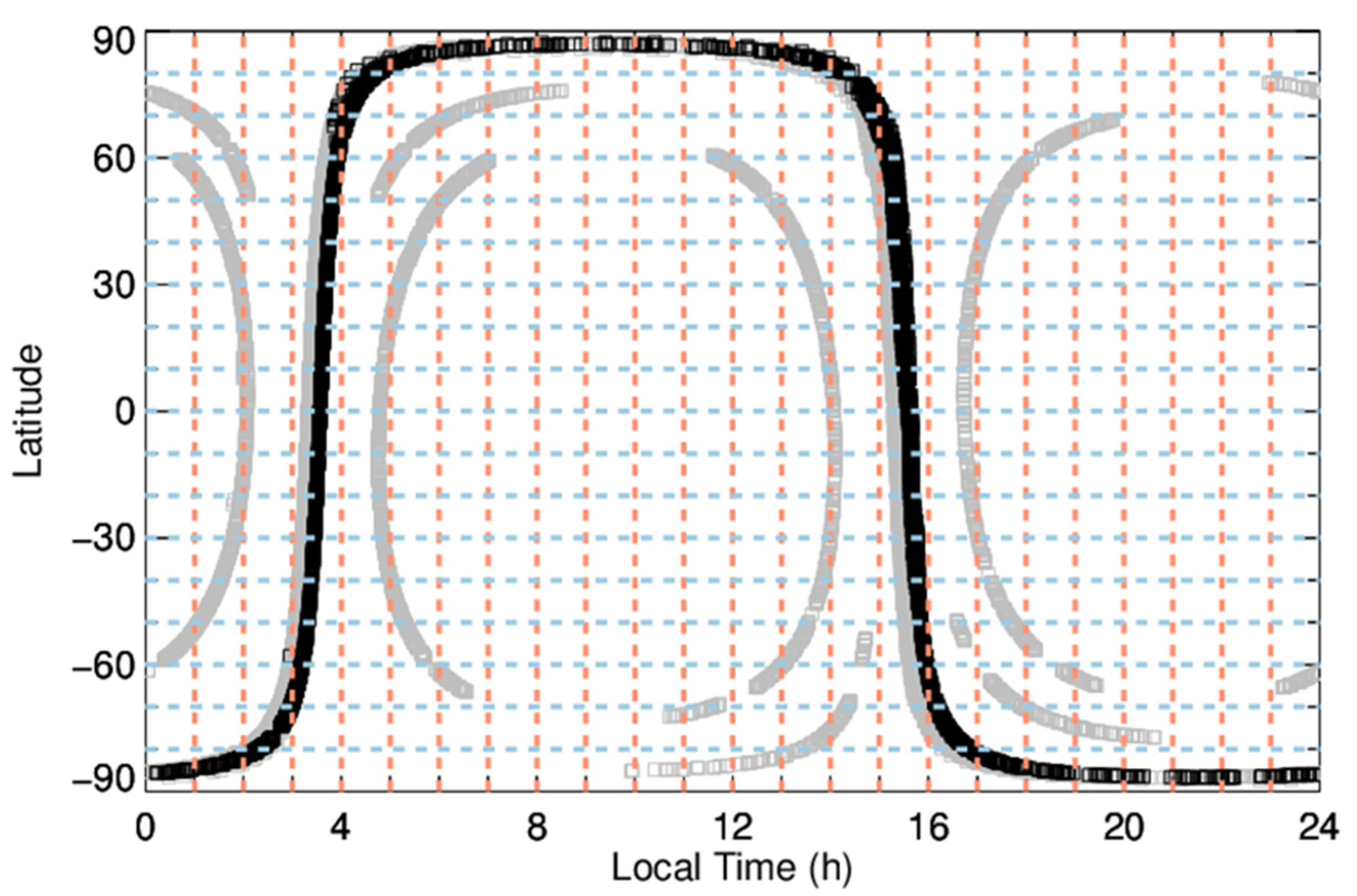
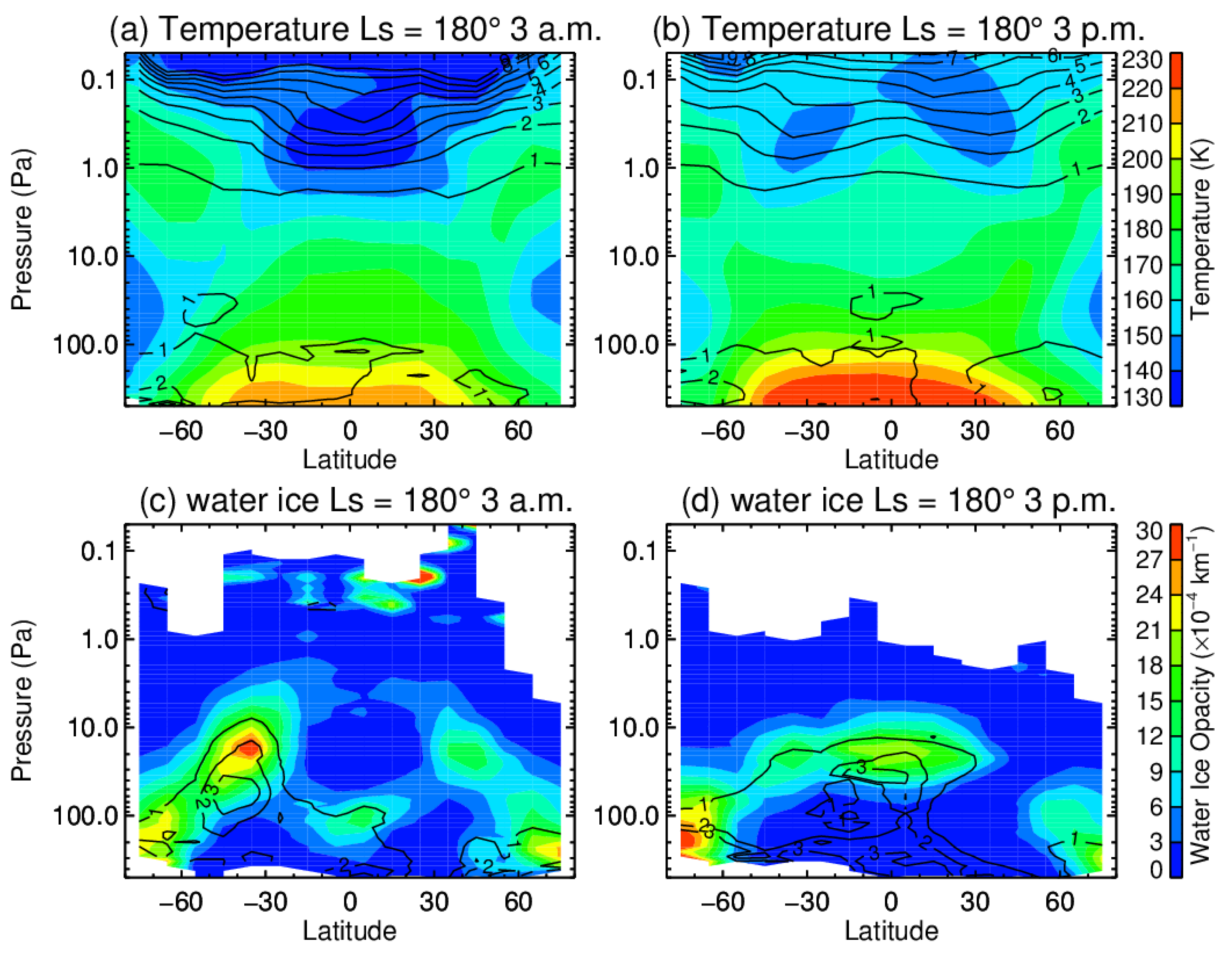
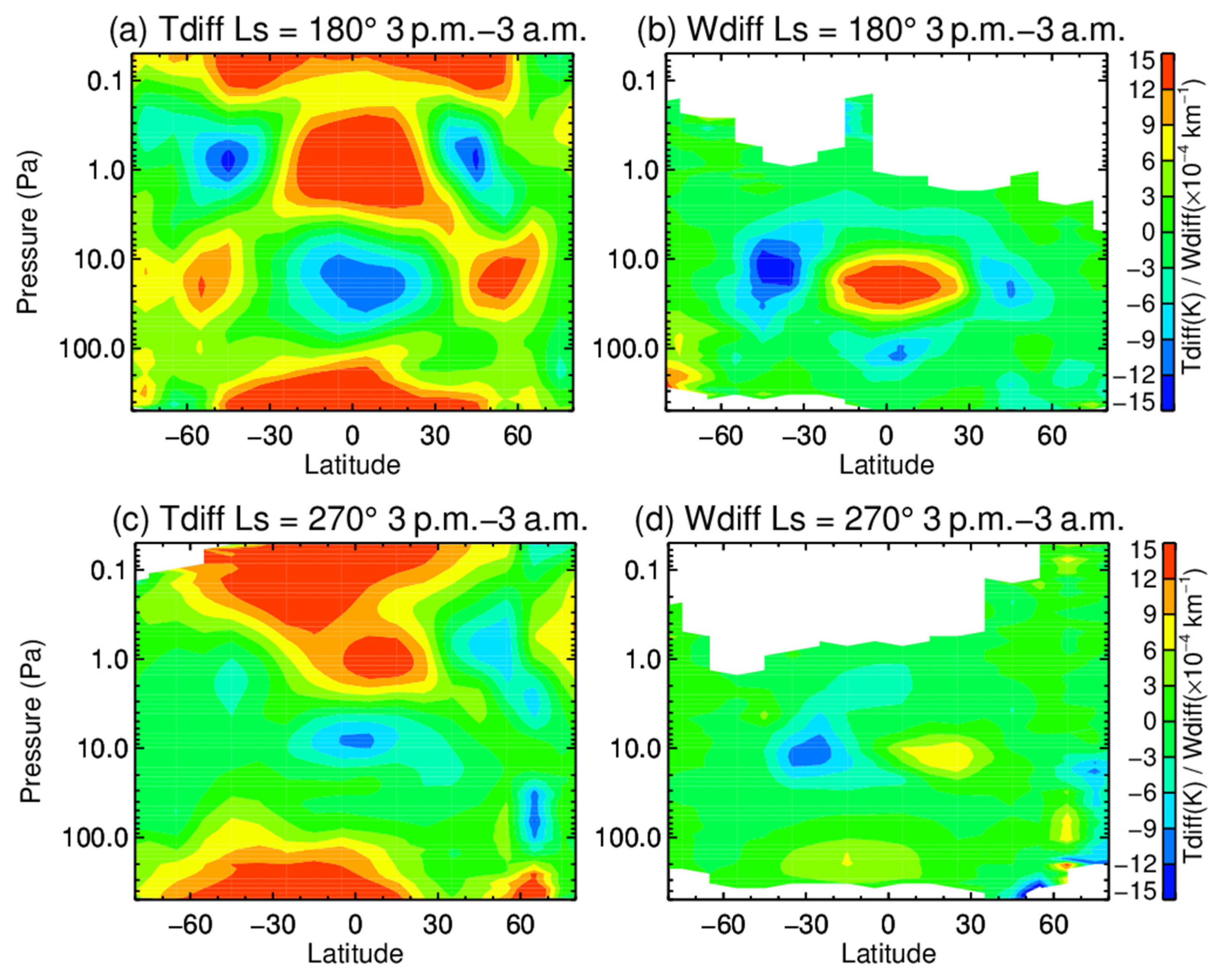
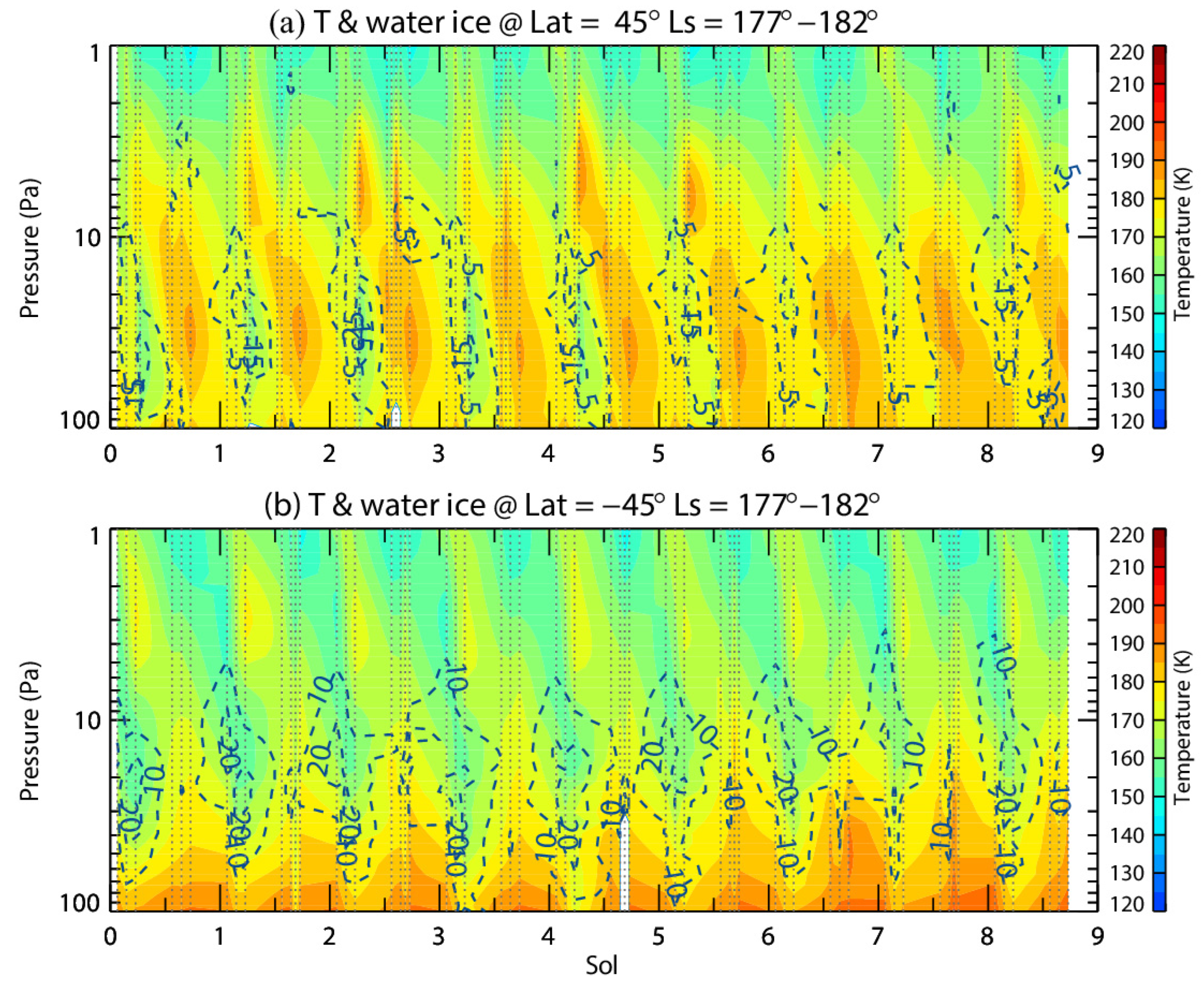
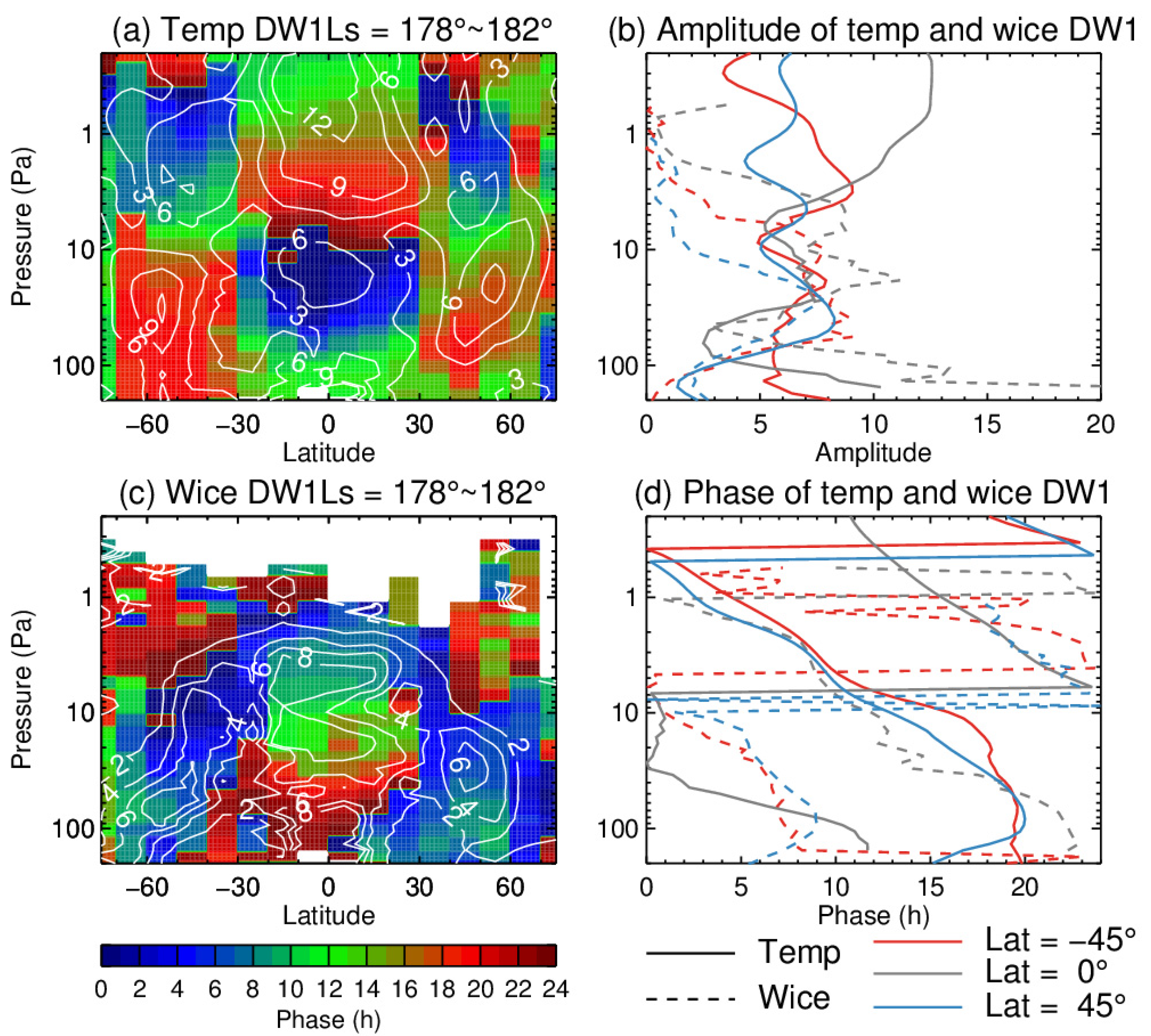
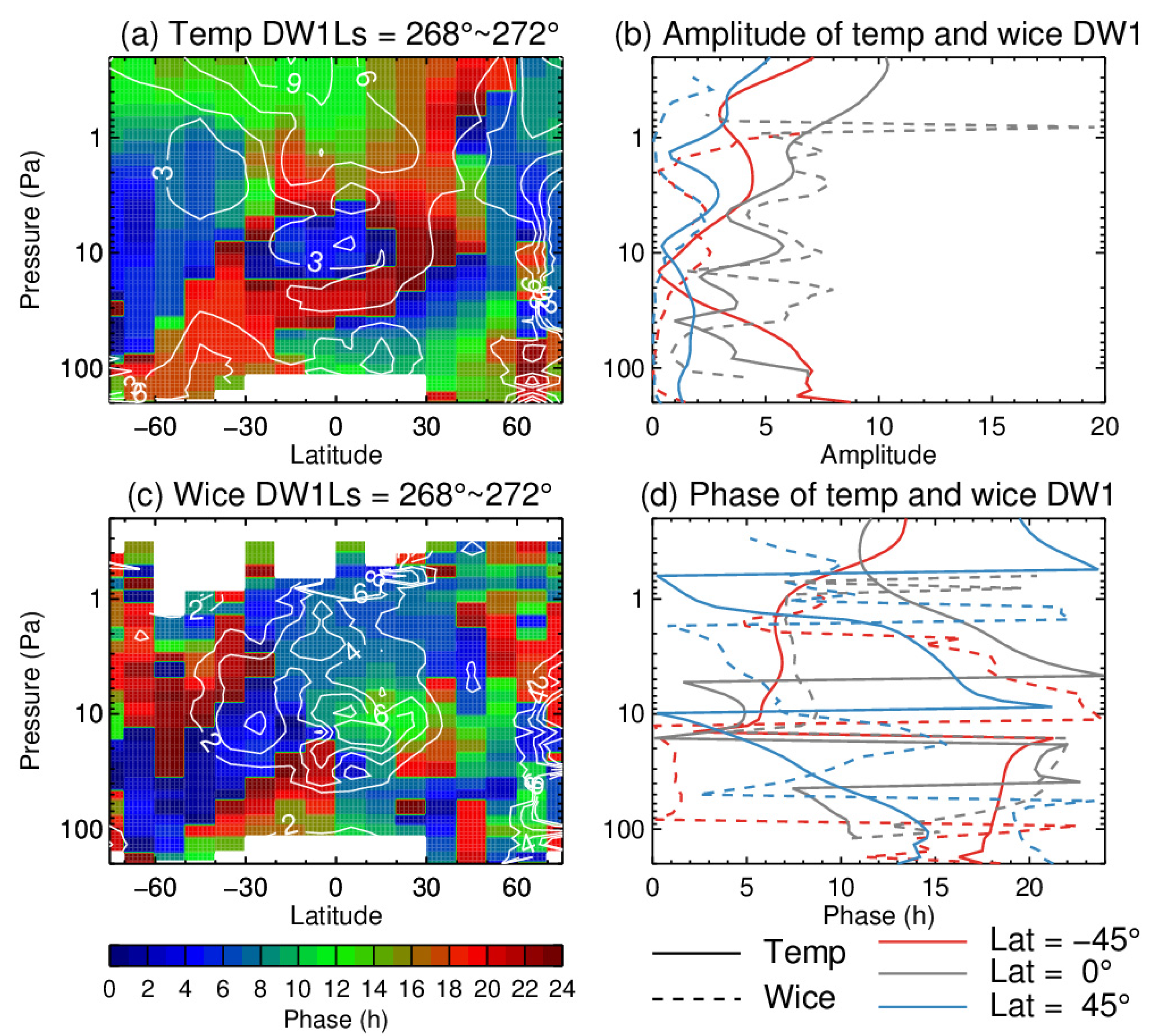
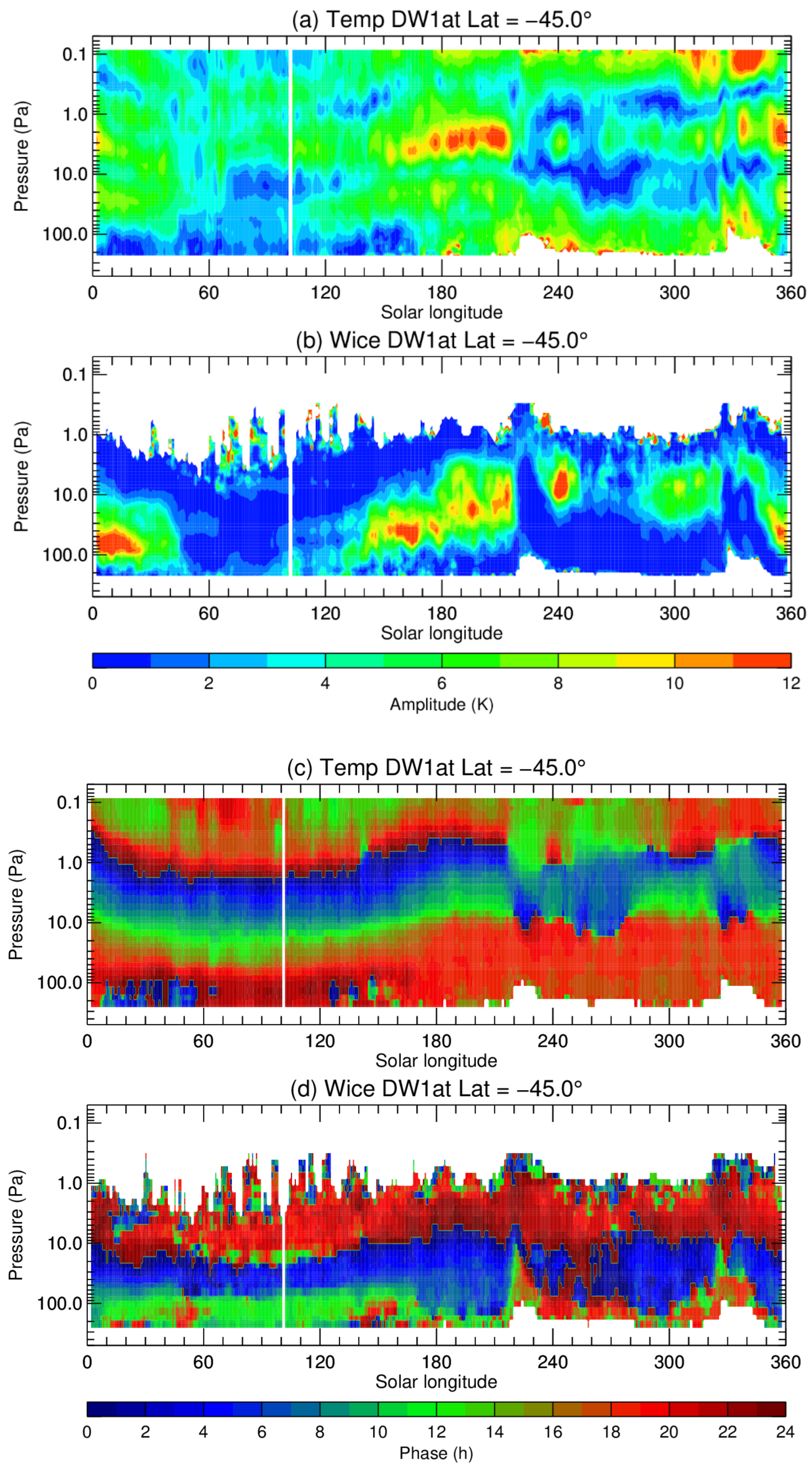
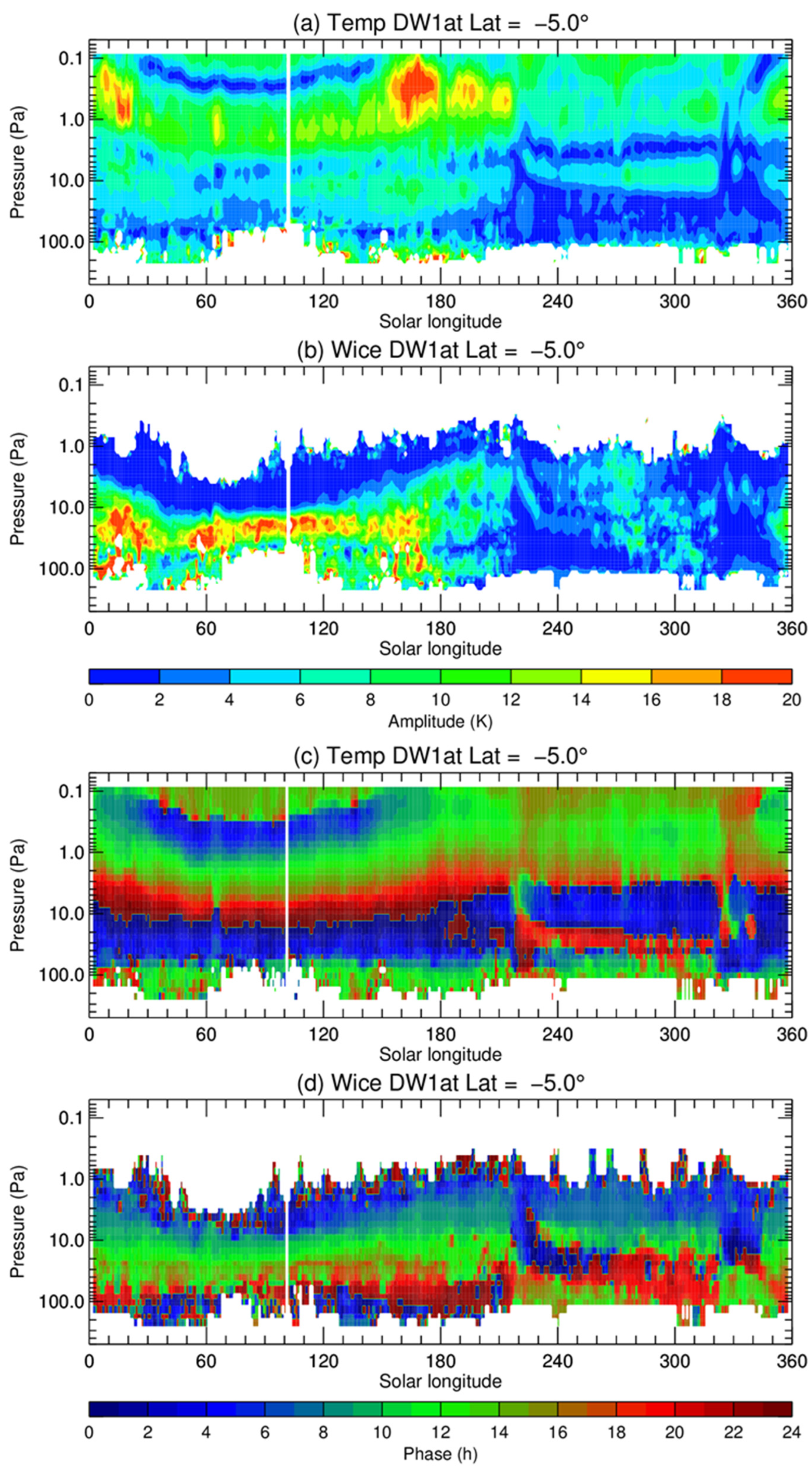
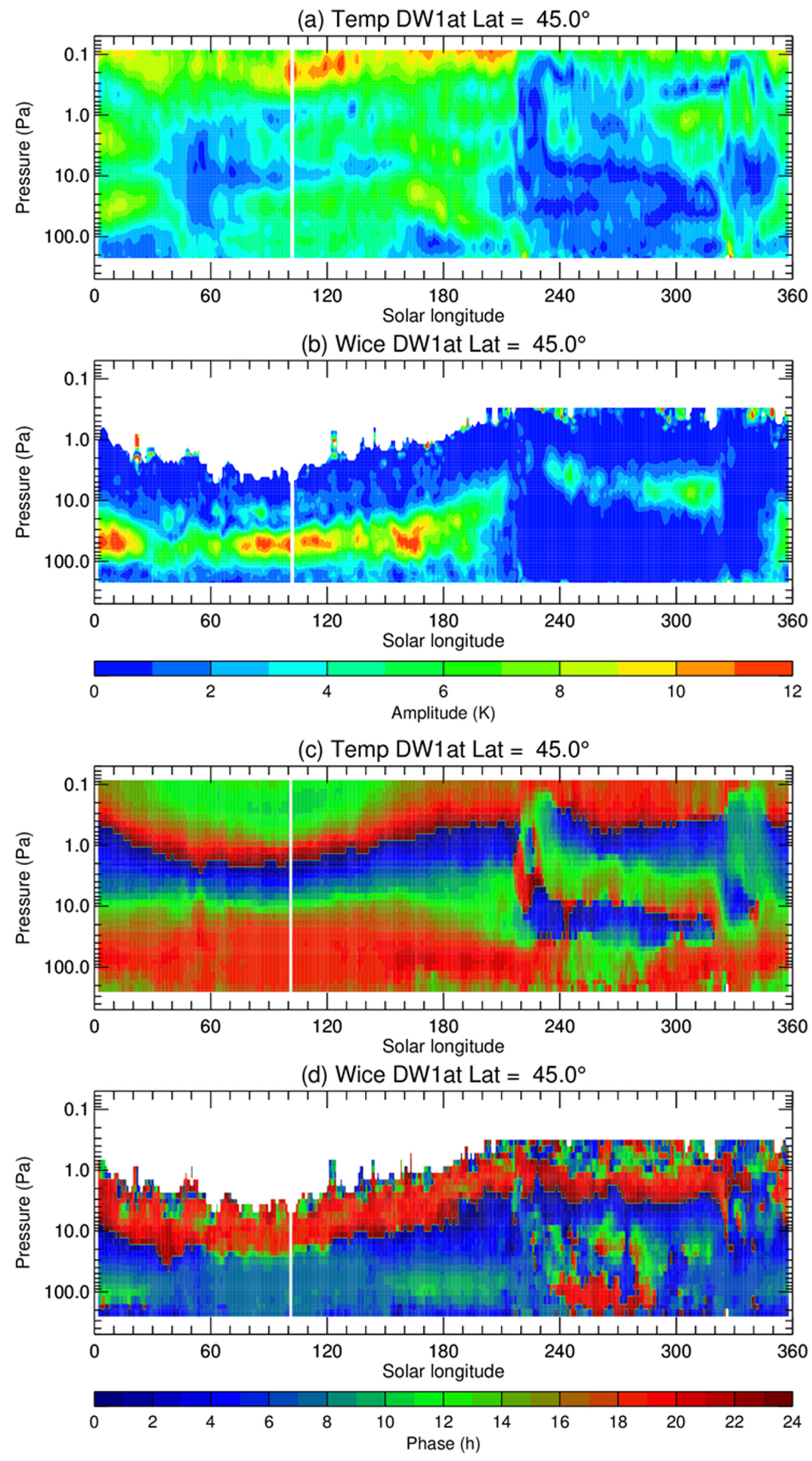
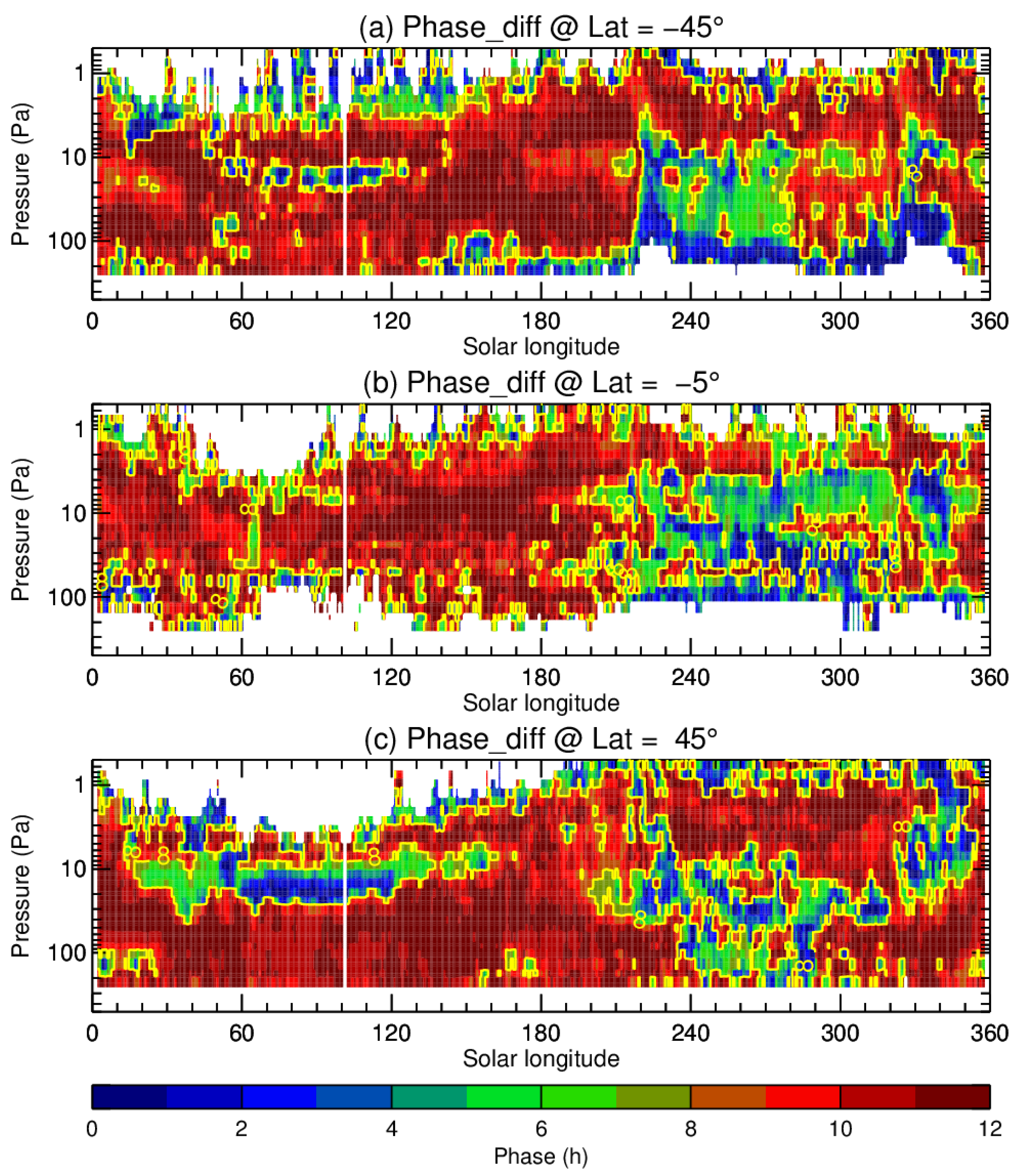
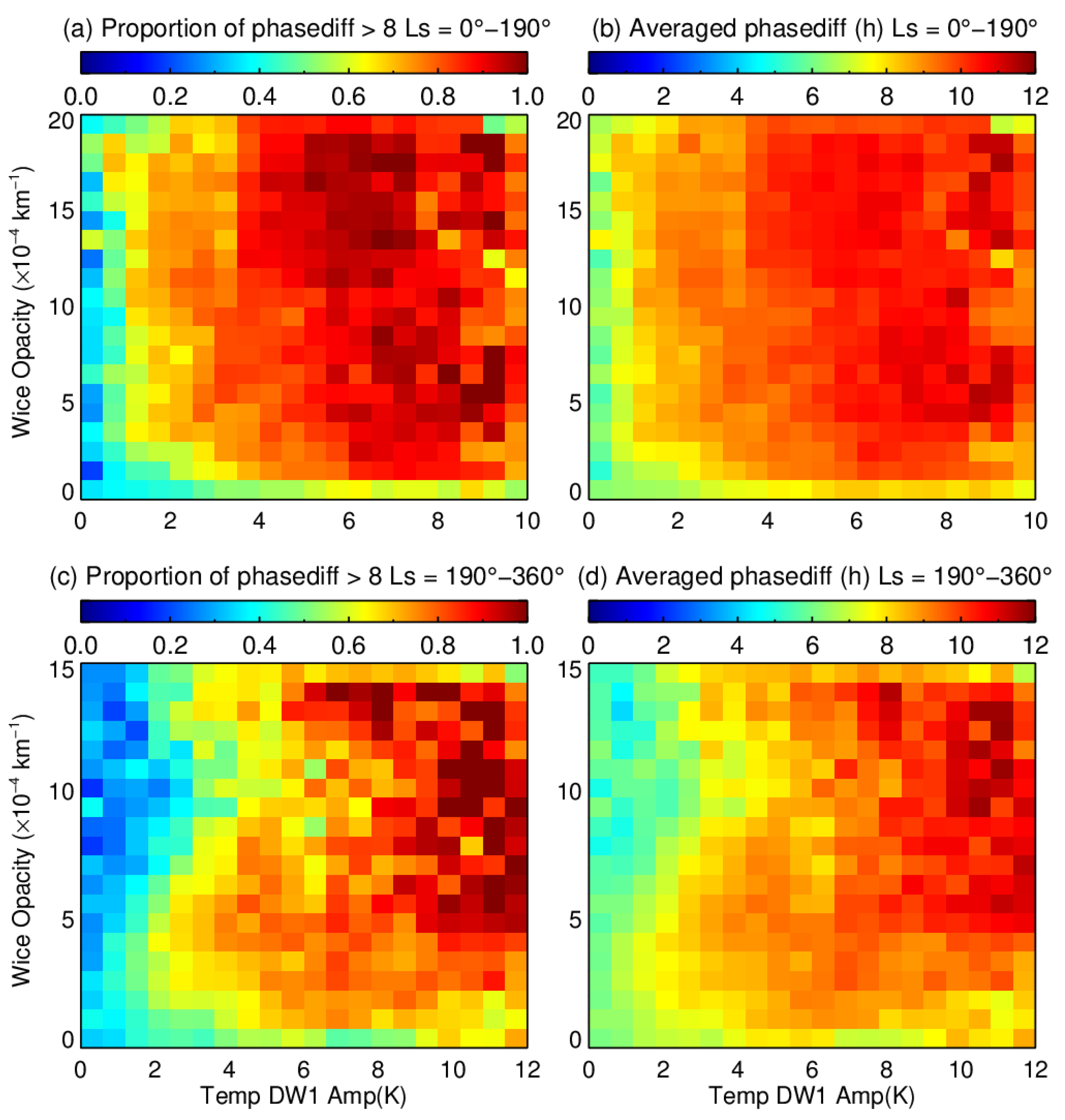
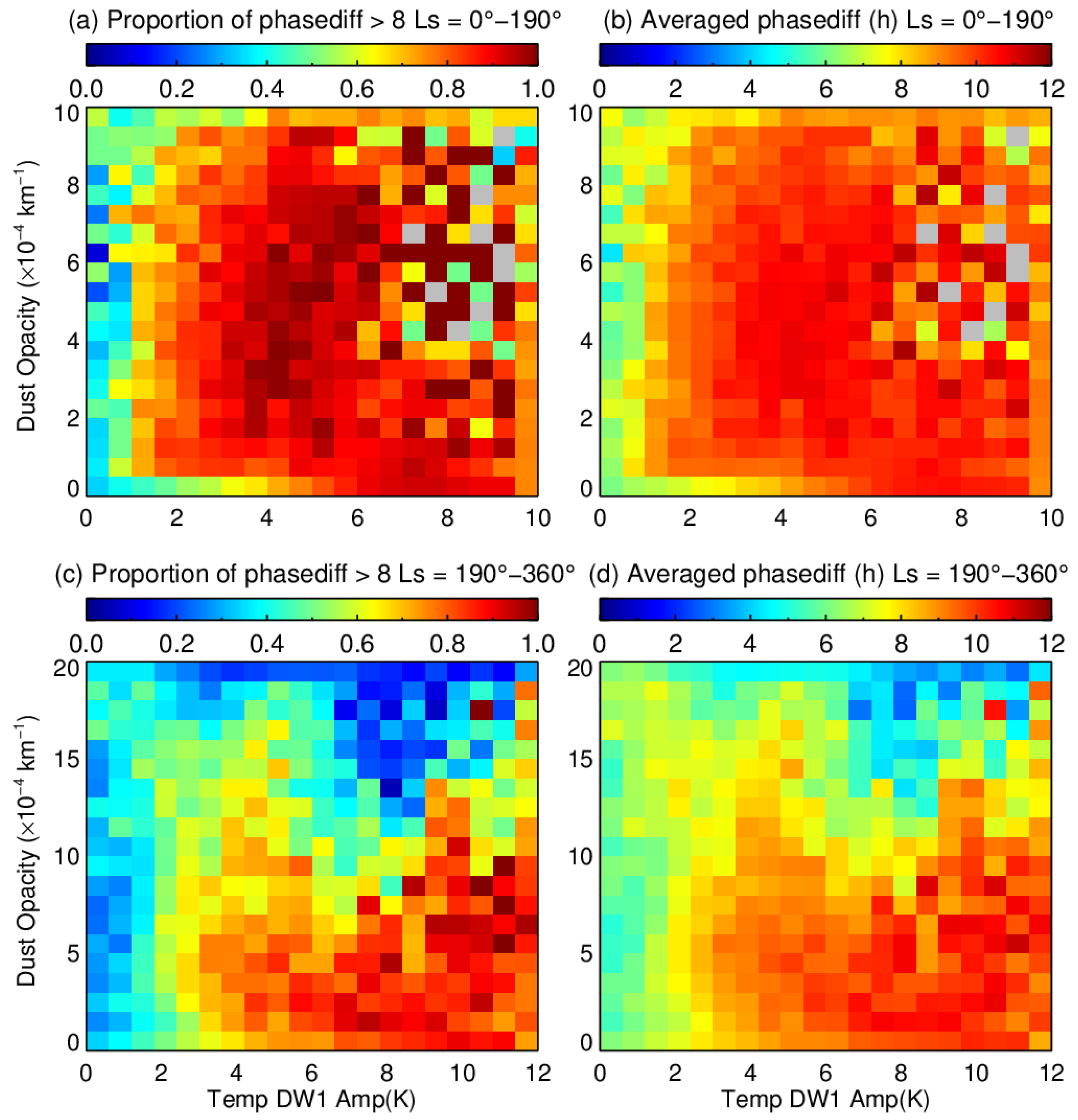
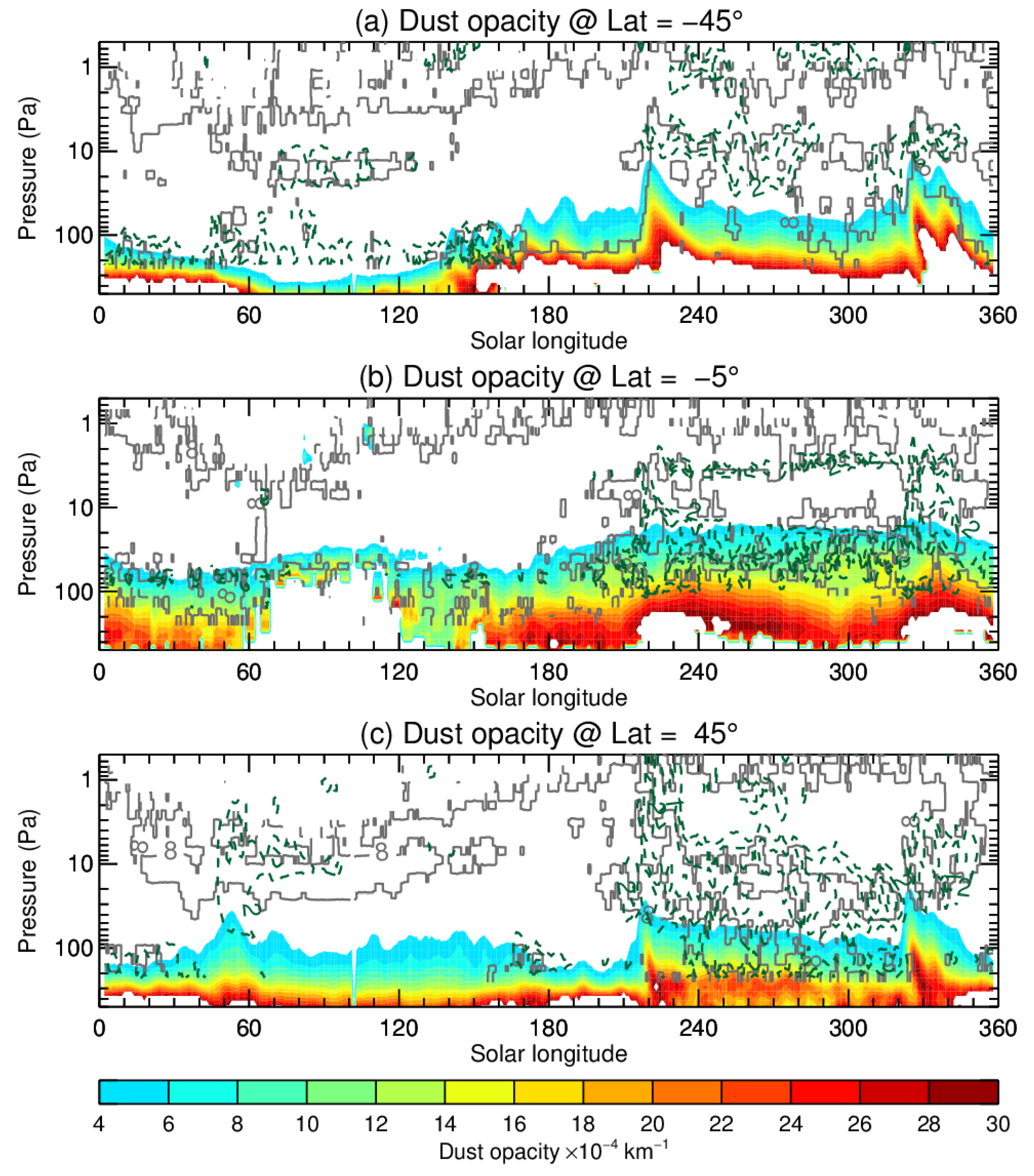
Publisher’s Note: MDPI stays neutral with regard to jurisdictional claims in published maps and institutional affiliations. |
© 2022 by the authors. Licensee MDPI, Basel, Switzerland. This article is an open access article distributed under the terms and conditions of the Creative Commons Attribution (CC BY) license (https://creativecommons.org/licenses/by/4.0/).
Share and Cite
Wu, Z.; Li, T.; Li, J.; Yang, C.; Cui, J. Diurnal Variations of Water Ice in the Martian Atmosphere Observed by Mars Climate Sounder. Remote Sens. 2022, 14, 2235. https://doi.org/10.3390/rs14092235
Wu Z, Li T, Li J, Yang C, Cui J. Diurnal Variations of Water Ice in the Martian Atmosphere Observed by Mars Climate Sounder. Remote Sensing. 2022; 14(9):2235. https://doi.org/10.3390/rs14092235
Chicago/Turabian StyleWu, Zhaopeng, Tao Li, Jing Li, Chengyun Yang, and Jun Cui. 2022. "Diurnal Variations of Water Ice in the Martian Atmosphere Observed by Mars Climate Sounder" Remote Sensing 14, no. 9: 2235. https://doi.org/10.3390/rs14092235
APA StyleWu, Z., Li, T., Li, J., Yang, C., & Cui, J. (2022). Diurnal Variations of Water Ice in the Martian Atmosphere Observed by Mars Climate Sounder. Remote Sensing, 14(9), 2235. https://doi.org/10.3390/rs14092235







